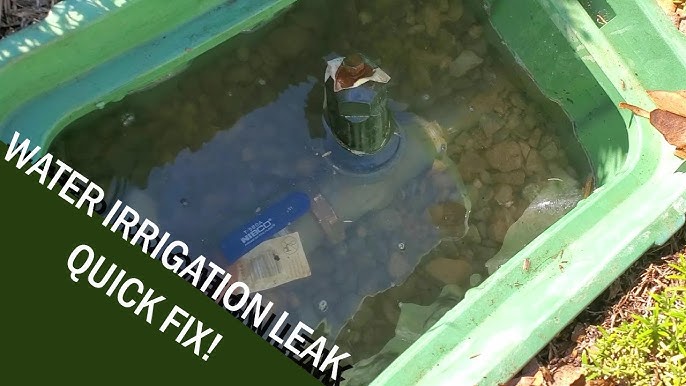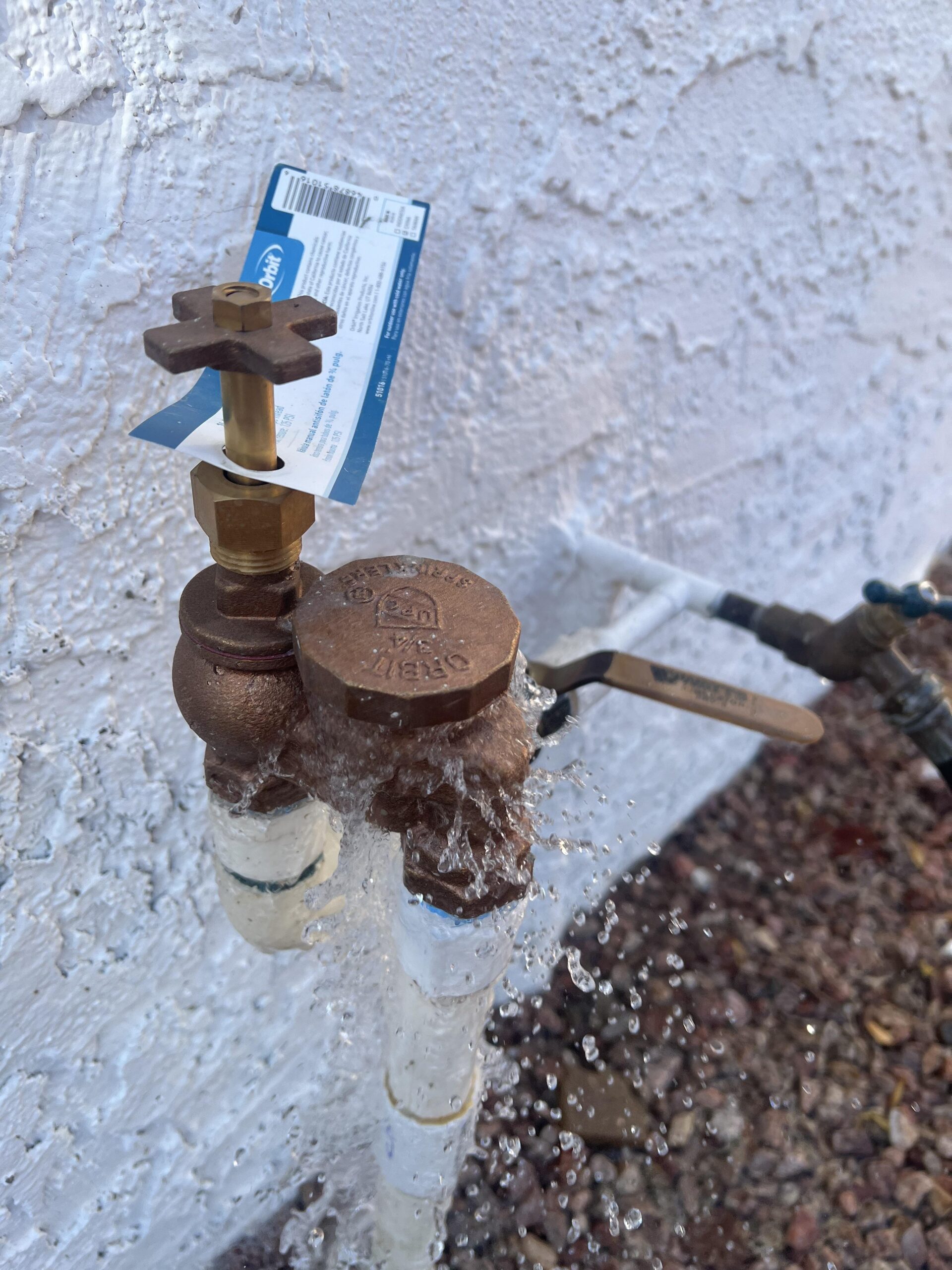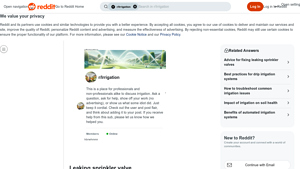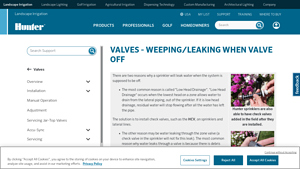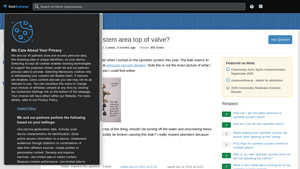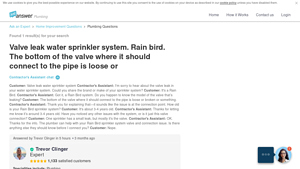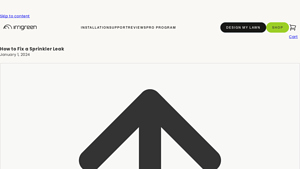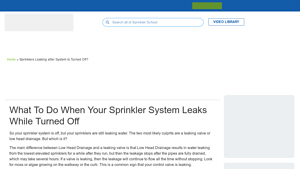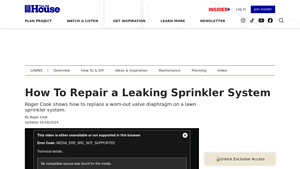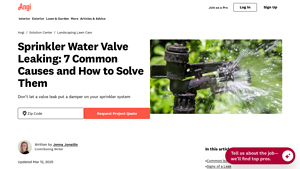Introduction: Navigating the Global Market for irrigation valve leaking water
In the quest for efficient agricultural practices, understanding the complexities of irrigation valve leaking water is paramount for international B2B buyers. As businesses across Africa, South America, the Middle East, and Europe strive for sustainable water management, the challenge of sourcing reliable irrigation solutions becomes evident. Leaking valves not only waste precious water resources but can also lead to increased operational costs and reduced system efficiency. This guide aims to equip decision-makers with the necessary knowledge to navigate the global market, addressing various types of irrigation valves, their applications, and common issues associated with leaks.
Throughout this comprehensive resource, buyers will discover actionable insights into identifying, troubleshooting, and sourcing high-quality irrigation valves. We delve into the nuances of supplier vetting, ensuring that buyers can confidently select partners that meet their specific needs. Furthermore, we provide a detailed overview of cost factors, empowering businesses to make informed purchasing decisions that align with their budgetary constraints and sustainability goals.
By understanding the implications of leaking irrigation valves and exploring effective solutions, B2B buyers can enhance their operational efficiency and contribute to sustainable water use in their regions. This guide serves as a vital tool for any organization looking to optimize its irrigation systems while fostering long-term partnerships with trusted suppliers.
Understanding irrigation valve leaking water Types and Variations
| Type Name | Key Distinguishing Features | Primary B2B Applications | Brief Pros & Cons for Buyers |
|---|---|---|---|
| Low Head Drainage | Water drains from the lowest sprinkler head when off | Residential and commercial landscaping | Pros: Simple fix with check valves; cost-effective. Cons: Can lead to water wastage if not addressed. |
| Valve Diaphragm Leakage | Water leaks through the valve due to debris or damage | Agricultural irrigation systems | Pros: Identifiable and repairable; prolongs system life. Cons: Requires regular maintenance to prevent issues. |
| O-Ring Failure | Leakage occurs at connection points due to worn O-rings | Golf courses, parks, and gardens | Pros: Easy to replace; minimal downtime. Cons: May require specific O-ring sizes; risk of recurring leaks. |
| Pressure Vacuum Breaker Leak | Leaks at the top of pressure vacuum breakers | Urban irrigation systems | Pros: Protects against backflow; essential for compliance. Cons: Complex repairs may need professional help. |
| Valve Body Cracking | Physical cracks in the valve body leading to significant leaks | Large-scale agricultural operations | Pros: Clear indication of failure; can be replaced. Cons: High replacement costs; potential system downtime. |
What are the Characteristics of Low Head Drainage in Irrigation Valves?
Low head drainage occurs when the lowest sprinkler head allows residual water to drain from the lateral piping, causing leaks when the system is off. This type of leakage is common in both residential and commercial landscaping applications. The solution typically involves installing check valves to prevent water from draining out, which is a cost-effective and straightforward fix. However, if ignored, it can lead to significant water wastage and affect overall irrigation efficiency.
How Does Valve Diaphragm Leakage Affect Irrigation Systems?
Valve diaphragm leakage is characterized by water leaking through the valve due to debris obstructing the diaphragm or damage to the valve itself. This issue is prevalent in agricultural irrigation systems where consistent water pressure is crucial. Identifying and repairing diaphragm leaks can prolong the life of the irrigation system and maintain efficiency. Regular maintenance is essential to prevent this type of leak, as neglect can lead to more severe issues.
What Are the Implications of O-Ring Failure in Irrigation Valves?
O-ring failure results in leaks at the connection points between the valve and the water source, typically due to wear and tear. This issue is particularly relevant in high-maintenance environments like golf courses and parks, where irrigation systems are under constant use. Replacing O-rings is a relatively simple task that can minimize downtime and repair costs. However, buyers must ensure they have the correct O-ring size to avoid recurring leakage issues.
Why Do Pressure Vacuum Breaker Leaks Occur in Urban Irrigation Systems?
Pressure vacuum breaker leaks typically occur at the top of the device, essential for preventing backflow in urban irrigation systems. These leaks can complicate compliance with local regulations regarding water safety. While the solution may require professional assistance for complex repairs, maintaining a functional pressure vacuum breaker is critical for protecting water quality. Buyers should consider the long-term implications of neglecting these leaks, which could lead to costly regulatory fines.
What Are the Risks Associated with Valve Body Cracking?
Cracking in the valve body is a serious issue that can lead to significant leaks and is often indicative of broader system failures. This problem is most commonly seen in large-scale agricultural operations where the stresses on valves are greater due to high water flow. The clear indication of failure allows for timely replacement, but buyers should be prepared for potentially high costs and system downtime during repairs. Investing in durable materials can mitigate the risk of such issues in the future.
Key Industrial Applications of irrigation valve leaking water
| Industry/Sector | Specific Application of irrigation valve leaking water | Value/Benefit for the Business | Key Sourcing Considerations for this Application |
|---|---|---|---|
| Agriculture | Crop irrigation systems with potential valve leaks | Reduces water wastage, ensures optimal crop yield | Durable materials to withstand local conditions, ease of maintenance |
| Landscaping | Maintenance of commercial landscape irrigation systems | Enhances aesthetic appeal, reduces operational costs | Reliable suppliers for quick replacements, availability of various valve types |
| Municipal Water Management | Public irrigation systems for parks and public spaces | Improves water conservation, maintains public health | Compliance with local regulations, compatibility with existing systems |
| Horticulture | Greenhouse irrigation systems addressing valve leaks | Maximizes plant health, minimizes water costs | Customizable solutions for diverse plant types, local support services |
| Sports Facilities | Irrigation for athletic fields experiencing valve issues | Ensures optimal playing conditions, reduces maintenance costs | Performance specifications for turf requirements, local climate adaptability |
How is ‘Irrigation Valve Leaking Water’ Applied in Agriculture?
In agriculture, leaking irrigation valves can severely impact crop yield by wasting water and disrupting the irrigation schedule. Farmers must monitor their systems to detect leaks promptly, as even small leaks can lead to substantial water loss. Buyers in this sector should prioritize sourcing durable, high-quality valves that can withstand harsh environmental conditions and have low maintenance requirements. Ensuring compatibility with existing irrigation systems is essential for seamless integration.
What Role Does ‘Irrigation Valve Leaking Water’ Play in Landscaping?
For landscaping businesses, managing irrigation valve leaks is crucial for maintaining lush green spaces in commercial properties. Leaks can lead to uneven watering, which affects the health of plants and increases operational costs due to higher water bills. Buyers should seek reliable suppliers that offer a variety of valve types, ensuring quick replacements and ease of installation. Additionally, sourcing valves that can endure varying climates will be beneficial for long-term sustainability.
How is ‘Irrigation Valve Leaking Water’ Managed in Municipal Water Management?
Municipalities face significant challenges with leaking irrigation valves in public parks and spaces. Such leaks not only waste water but can also create unsafe conditions, such as slippery walkways. Effective management of these systems is critical for public health and environmental conservation. Buyers in this sector need to consider compliance with local regulations and the compatibility of new valves with existing municipal systems to ensure efficient water management.
What is the Importance of ‘Irrigation Valve Leaking Water’ in Horticulture?
In horticulture, greenhouse operators must address valve leaks to maintain optimal moisture levels for delicate plants. Leaks can lead to over-saturation, harming plant health and increasing costs. Buyers should look for customizable irrigation solutions that cater to diverse plant types and ensure local support services are available for timely maintenance. This approach helps maximize plant health and minimize water costs, enhancing overall profitability.
How Does ‘Irrigation Valve Leaking Water’ Affect Sports Facilities?
Sports facilities rely heavily on effective irrigation systems to maintain optimal playing conditions. Leaking valves can compromise the quality of turf, leading to poor playing conditions and increased maintenance efforts. It is essential for facility managers to source valves that meet specific performance specifications tailored to the type of turf and local climate. Considering local climate adaptability in sourcing decisions can significantly reduce long-term operational costs and enhance the user experience.
3 Common User Pain Points for ‘irrigation valve leaking water’ & Their Solutions
Scenario 1: Unanticipated Water Loss Disrupting Operations
The Problem: Many agricultural companies and landscape service providers experience significant challenges when irrigation valves leak, leading to unexpected water loss. This not only increases operational costs but can also affect crop yields and the health of landscaped areas. For instance, a landscape contractor managing multiple properties may find that a leaking valve leads to over-saturation in one area and drought-like conditions in another, resulting in additional expenses for both water and potential rework of affected areas. The unpredictability of these leaks can strain resources, disrupt schedules, and create dissatisfaction among clients.
The Solution: To address this issue, companies should invest in high-quality irrigation valves equipped with built-in check valves. These valves help prevent backflow and minimize drainage when the system is off, thus reducing the risk of leaks. Additionally, implementing a regular maintenance schedule is crucial; this includes routine inspections and timely repairs of any worn components. Training staff to identify early signs of leaks—such as unusually wet areas or decreased water pressure—can also enhance responsiveness. By sourcing valves from reputable manufacturers that offer durable materials and warranties, buyers can ensure long-term reliability and minimize operational disruptions.
Scenario 2: Increased Utility Costs and Environmental Impact
The Problem: A significant pain point for businesses is the financial burden associated with increased water bills due to leaking irrigation valves. This issue is particularly pressing in regions where water is scarce and utility costs are high. For instance, a nursery relying on a sophisticated irrigation system may notice a spike in its monthly water bill, prompting concerns not only about operational costs but also about environmental responsibility. Excessive water use can lead to scrutiny from regulatory bodies and damage the company’s reputation in environmentally conscious markets.
The Solution: To combat this problem, buyers should consider investing in smart irrigation technology that includes leak detection features. These systems can provide real-time monitoring of water flow and pressure, alerting users to potential leaks before they escalate. Furthermore, adopting a proactive approach by installing high-quality, corrosion-resistant valves can significantly reduce the likelihood of leaks. Conducting a thorough water audit can also help businesses identify areas for improvement and optimize their irrigation practices. By prioritizing efficiency and sustainability, companies can not only lower costs but also enhance their standing as responsible environmental stewards.
Scenario 3: Client Dissatisfaction from Inconsistent Watering
The Problem: Landscape maintenance companies often face client dissatisfaction stemming from inconsistent watering due to faulty irrigation valves. For example, a commercial landscaping firm may find that a leaking valve causes certain areas to receive too much water while others remain dry, leading to uneven growth and potentially damaging valuable plants. This inconsistency can harm client relationships and jeopardize future contracts, as clients expect reliable service and optimal results.
The Solution: To maintain client satisfaction, it is essential to establish a comprehensive irrigation management plan. This includes regular system evaluations to ensure all components, especially valves, are functioning correctly. Incorporating pressure-regulating valves can help maintain consistent water distribution across the system. Additionally, providing clients with transparent communication regarding maintenance schedules and any necessary repairs can build trust. Offering irrigation system upgrades, such as smart controllers that adjust watering based on weather conditions, not only enhances service quality but also demonstrates a commitment to delivering optimal results for clients. By proactively addressing potential issues, companies can enhance client satisfaction and secure long-term relationships.
Strategic Material Selection Guide for irrigation valve leaking water
What Materials Are Commonly Used for Irrigation Valves to Prevent Water Leaks?
When selecting materials for irrigation valves, particularly in regions prone to leaks, it is essential to consider properties such as durability, corrosion resistance, and compatibility with various media. Below are analyses of four common materials used in the construction of irrigation valves, along with their advantages, disadvantages, and specific considerations for international B2B buyers.
1. Brass
Key Properties: Brass is known for its excellent corrosion resistance and strength under high pressure, making it suitable for a variety of irrigation applications. It typically has a temperature rating of up to 200°C (392°F) and can withstand high pressure.
Pros & Cons: The durability of brass is a significant advantage, as it can last for many years without degrading. However, brass can be relatively expensive compared to other materials, and its manufacturing process can be complex, requiring skilled labor.
Impact on Application: Brass is compatible with various media, including water and certain chemicals, making it versatile for different irrigation systems.
Considerations for International Buyers: Compliance with standards such as ASTM B36 (for brass) is crucial. Buyers in regions like Africa and South America should consider local availability and cost implications due to import tariffs.
2. PVC (Polyvinyl Chloride)
Key Properties: PVC is lightweight, cost-effective, and resistant to corrosion. It is rated for temperatures up to 60°C (140°F) and can handle moderate pressure.
Pros & Cons: The primary advantage of PVC is its low cost and ease of installation, making it a popular choice for budget-conscious projects. However, it may not perform well in extremely high temperatures or under high pressure, which could lead to leaks.
Impact on Application: PVC is suitable for water and some chemical media but may degrade when exposed to UV light unless treated.
Considerations for International Buyers: Compliance with local standards such as DIN 8061 is essential. In regions like the Middle East, UV resistance is a critical factor due to high sun exposure.
3. Stainless Steel
Key Properties: Stainless steel offers exceptional corrosion resistance and can withstand high temperatures and pressures, often rated up to 300°C (572°F).
Pros & Cons: The durability of stainless steel makes it ideal for harsh environments, but it comes at a higher cost. Additionally, the manufacturing process can be complex, requiring specialized equipment.
Impact on Application: Stainless steel is compatible with a wide range of media, including aggressive chemicals, making it suitable for diverse irrigation applications.
Considerations for International Buyers: Buyers should ensure compliance with standards such as ASTM A312. In Europe, the EN 10088 standard is also relevant. Buyers should consider the availability of stainless steel in local markets to avoid delays.
4. Polypropylene
Key Properties: Polypropylene is lightweight and resistant to chemical corrosion, with a temperature rating of up to 100°C (212°F).
Pros & Cons: Its low cost and ease of installation are significant advantages. However, polypropylene may not withstand high pressure as effectively as metal options, which could lead to potential leaks.
Impact on Application: Polypropylene is suitable for a variety of media, particularly in agricultural applications where chemical resistance is essential.
Considerations for International Buyers: Compliance with ISO standards is important. In regions like Africa and South America, local sourcing can reduce costs and improve supply chain efficiency.
Summary Table
| Material | Typical Use Case for irrigation valve leaking water | Key Advantage | Key Disadvantage/Limitation | Relative Cost (Low/Med/High) |
|---|---|---|---|---|
| Brass | High-pressure irrigation systems | Excellent corrosion resistance | Higher cost and complex manufacturing | High |
| PVC | Residential irrigation systems | Cost-effective and lightweight | Limited pressure and temperature resistance | Low |
| Stainless Steel | Industrial irrigation applications | Exceptional durability and resistance | Higher cost and complex manufacturing | High |
| Polypropylene | Agricultural applications with chemical exposure | Lightweight and chemically resistant | Limited pressure tolerance | Medium |
This analysis provides valuable insights for B2B buyers considering materials for irrigation valves, highlighting the importance of selecting the right material based on application needs, cost, and regional compliance standards.
In-depth Look: Manufacturing Processes and Quality Assurance for irrigation valve leaking water
What Are the Main Stages in the Manufacturing Process of Irrigation Valves?
The manufacturing process for irrigation valves, particularly those that are susceptible to leaking, involves several critical stages. These stages ensure that the final product is durable, reliable, and capable of withstanding various environmental conditions.
Material Preparation: Which Materials Are Commonly Used?
The first step in manufacturing irrigation valves is material selection and preparation. Common materials include brass, stainless steel, and high-density polyethylene (HDPE). Each material offers unique benefits: brass is known for its corrosion resistance, stainless steel provides strength and longevity, while HDPE is lightweight and resistant to chemicals. The materials undergo quality checks to ensure they meet industry standards before being processed further.
Forming: How Are Irrigation Valves Shaped?
Once the materials are prepared, the next stage is forming. This can involve casting, forging, or machining processes. Casting is often used for brass and stainless steel valves, where molten metal is poured into a mold to create the desired shape. For HDPE valves, extrusion techniques may be employed, where the plastic is forced through a mold to form long sections that are then cut to size. The forming process is critical as it dictates the valve’s structural integrity and performance.
Assembly: What Are the Key Techniques Used?
The assembly stage is where various components come together to create the finished irrigation valve. This includes fitting the valve body, diaphragm, and seals. Advanced techniques like automated assembly lines may be used to enhance efficiency and precision. For instance, the use of robotics in placing O-rings and other seals can minimize human error, which is essential for preventing leaks. Each valve is assembled according to strict specifications to ensure compatibility and functionality.
Finishing: How Is the Final Product Prepared?
The final stage is finishing, which includes surface treatments and coatings to enhance durability and resistance to environmental factors. Processes such as electroplating, powder coating, or anodizing are common. These treatments not only improve the aesthetic appeal but also provide additional protection against corrosion and wear, which are critical for irrigation valves exposed to various weather conditions.
What International Standards and Quality Assurance Practices Are Relevant?
Quality assurance (QA) in the manufacturing of irrigation valves is paramount, especially for B2B buyers concerned about reliability and performance. Various international standards guide manufacturers to ensure that their products meet high-quality benchmarks.
What International Standards Should B2B Buyers Look For?
ISO 9001 is one of the most recognized international quality management standards. It emphasizes a process-oriented approach to quality, ensuring that companies consistently meet customer and regulatory requirements. Compliance with ISO 9001 indicates that a manufacturer has a robust quality management system in place.
In addition to ISO standards, industry-specific certifications such as CE marking (indicating conformity with health, safety, and environmental protection standards) and API (American Petroleum Institute) certifications are critical for valves used in specific applications. Buyers should inquire about these certifications during the procurement process to ensure compliance with local and international regulations.
What Are the Key Quality Control Checkpoints in the Manufacturing Process?
To maintain high standards of quality, manufacturers implement several checkpoints throughout the production process.
How Is Incoming Quality Control (IQC) Conducted?
Incoming Quality Control (IQC) is the first checkpoint, where raw materials are inspected for quality and compliance with specifications. This step is crucial, as the quality of materials directly affects the performance and durability of the final product.
What Is In-Process Quality Control (IPQC)?
In-Process Quality Control (IPQC) takes place during the manufacturing process. Regular inspections and testing are performed to ensure that the production parameters are being met. For instance, dimensional checks and functional tests on valve components can prevent defects from reaching the assembly stage.
What Is Final Quality Control (FQC)?
Finally, Final Quality Control (FQC) occurs once the valves are fully assembled. This stage involves rigorous testing, including pressure testing and leak testing, to verify that the valves function correctly under expected operating conditions. Any valves that do not meet the required standards are either reworked or discarded.
How Can B2B Buyers Verify Supplier Quality Control?
For B2B buyers, especially those in international markets, verifying a supplier’s quality control measures is essential to ensure that they receive reliable products.
What Steps Can Buyers Take to Ensure Quality?
Buyers should request documentation of the supplier’s quality management systems, including ISO certification and any relevant industry-specific certifications. Additionally, they can ask for quality control reports that detail the results of IQC, IPQC, and FQC processes.
How Important Are Audits and Third-Party Inspections?
Conducting audits and engaging third-party inspectors can further verify a supplier’s quality practices. Audits can provide insights into the manufacturing process, while third-party inspections can offer an unbiased evaluation of product quality. This is particularly important for buyers from regions like Africa and South America, where local regulations may differ from international standards.
What Are the Quality Control Nuances for International B2B Buyers?
Understanding the nuances of quality control in different regions is crucial for international B2B buyers. For instance, the regulatory environment in the Middle East may impose additional compliance requirements that differ from European standards. Buyers should familiarize themselves with these regional differences to avoid complications during procurement.
In conclusion, the manufacturing processes and quality assurance practices for irrigation valves are critical for preventing leaks and ensuring long-term reliability. By understanding these processes and actively verifying supplier quality, B2B buyers can make informed decisions that align with their operational needs and compliance requirements.
Practical Sourcing Guide: A Step-by-Step Checklist for ‘irrigation valve leaking water’
Introduction
In the world of irrigation systems, timely and effective maintenance is critical to ensure optimal performance and water conservation. When dealing with issues like leaking irrigation valves, it’s essential for B2B buyers to have a structured approach to sourcing the right solutions. This guide outlines practical steps to help you identify, evaluate, and procure the necessary products and services to address leaking irrigation valves efficiently.
Step 1: Identify the Type of Leak
Understanding the type of leak is the first step in addressing the issue effectively. Common signs include unusually wet areas in the lawn, an increased water bill, or low water pressure in the system. Each type of leak may require different solutions, so accurately diagnosing the problem is crucial for effective sourcing.
Step 2: Define Your Technical Specifications
Before reaching out to suppliers, outline the specific technical requirements for your irrigation system. Consider factors such as valve size, pressure ratings, and compatibility with existing systems. Clear specifications help streamline communication with suppliers and ensure you receive appropriate solutions tailored to your needs.
Step 3: Research Potential Suppliers
Conduct thorough research to identify reputable suppliers specializing in irrigation components. Look for companies with a strong track record in your region, particularly those familiar with local conditions and regulations. Utilize online resources, industry publications, and trade shows to create a list of potential partners.
Step 4: Evaluate Supplier Certifications and Quality Assurance
Certifications and quality assurance processes are vital indicators of a supplier’s reliability. Verify that potential suppliers adhere to international standards, such as ISO certifications or local agricultural guidelines. High-quality products reduce the risk of future leaks and ensure long-term performance.
Step 5: Request Product Samples and Technical Support
Before finalizing any procurement decisions, request product samples to evaluate their quality firsthand. Additionally, inquire about the availability of technical support, installation guidance, and maintenance resources. This support can be invaluable in ensuring proper installation and ongoing performance of the irrigation valves.
Step 6: Compare Pricing and Warranty Options
Once you have gathered information from multiple suppliers, compare pricing structures and warranty options. While cost is a significant factor, also consider the value provided through warranties and support services. A slightly higher initial investment may result in lower long-term costs due to reduced maintenance and replacement needs.
Step 7: Finalize Contracts and Establish Communication Channels
After selecting a supplier, ensure that all contractual details are clear, including delivery timelines, payment terms, and after-sales support. Establish open communication channels for ongoing dialogue regarding product performance and any future needs. This relationship is crucial for addressing potential issues swiftly and maintaining an efficient irrigation system.
By following these steps, B2B buyers can effectively source solutions for leaking irrigation valves, ensuring their systems operate efficiently and sustainably.
Comprehensive Cost and Pricing Analysis for irrigation valve leaking water Sourcing
What Are the Key Cost Components for Sourcing Irrigation Valve Solutions?
When sourcing irrigation valves to address leaking issues, understanding the cost structure is crucial for B2B buyers. The major cost components include:
Materials: The choice of materials significantly influences costs. High-quality rubber for O-rings, durable plastics, or corrosion-resistant metals can increase initial expenses but may reduce long-term maintenance costs.
Labor: Labor costs encompass both installation and ongoing maintenance. In regions with higher labor rates, such as parts of Europe, these costs can be substantial. Conversely, countries with lower labor costs may offer more competitive pricing.
Manufacturing Overhead: This includes costs related to facility operations, equipment depreciation, and utilities. Efficient manufacturing processes can help mitigate overhead costs.
Tooling: Custom tooling for specific valve designs can add to the upfront costs. Standardized parts typically have lower tooling costs and can be sourced more easily.
Quality Control (QC): Implementing robust QC processes ensures that valves meet required specifications. This can involve additional costs but is essential for preventing future leaks and associated repairs.
Logistics: Shipping and handling costs can vary widely based on the distance and shipping method. International buyers should consider local regulations and potential tariffs that may impact total logistics costs.
Margin: Supplier profit margins can vary based on market conditions, brand reputation, and competition. Negotiating favorable terms can enhance cost efficiency.
What Price Influencers Should International Buyers Consider?
Several factors can influence pricing when sourcing irrigation valves for leak repairs:
Volume and Minimum Order Quantity (MOQ): Larger orders often qualify for discounts. Understanding the MOQ can help buyers assess whether they can achieve cost savings through bulk purchasing.
Specifications and Customization: Custom valves designed for specific applications may incur higher costs. Standardized products can be more economical, but buyers must balance cost with performance needs.
Materials and Quality Certifications: Higher-quality materials typically lead to increased costs. Certifications, such as ISO or specific agricultural standards, can also affect pricing, as certified products often command higher market value.
Supplier Factors: The reputation and reliability of suppliers can impact pricing. Established suppliers may charge more but offer better warranties and support, which can reduce Total Cost of Ownership (TCO).
Incoterms: Understanding shipping terms (e.g., FOB, CIF) is vital for cost management. These terms define who is responsible for shipping costs and risks, which can significantly affect the final price.
How Can Buyers Optimize Negotiation and Cost Efficiency?
To maximize value when sourcing irrigation valves, buyers should consider the following strategies:
Negotiate Terms: Engage suppliers in discussions about pricing, payment terms, and delivery schedules. Building a relationship can lead to better terms and discounts.
Evaluate Total Cost of Ownership (TCO): Assess not only the purchase price but also maintenance, operational costs, and potential downtime due to leaks. Investing in higher-quality valves may yield savings over time.
Understand Pricing Nuances for Different Regions: Pricing can vary by region due to factors such as local demand, supply chain logistics, and economic conditions. International buyers should conduct market research to identify the best sourcing options.
Leverage Group Purchasing: Collaborating with other businesses can increase order volumes and improve negotiation leverage with suppliers.
Stay Informed on Market Trends: Keeping abreast of changes in material costs, labor rates, and technological advancements can help buyers make informed decisions and anticipate pricing shifts.
Disclaimer on Indicative Prices
Prices for irrigation valves can vary widely based on the aforementioned factors. It is essential for buyers to obtain multiple quotes and conduct thorough due diligence before making purchasing decisions. Always consider potential fluctuations in costs due to market dynamics and local conditions.
Alternatives Analysis: Comparing irrigation valve leaking water With Other Solutions
In the quest for effective irrigation solutions, addressing the issue of leaking irrigation valves is essential. However, there are alternative technologies and methods available that can mitigate water loss and enhance irrigation efficiency. This analysis compares the traditional problem of irrigation valve leaks with two viable alternatives: Drip Irrigation Systems and Smart Irrigation Controllers.
Comparison Table
| Comparison Aspect | Irrigation Valve Leaking Water | Drip Irrigation Systems | Smart Irrigation Controllers |
|---|---|---|---|
| Performance | Leads to water wastage and uneven distribution. | Delivers water directly to plant roots, minimizing waste. | Optimizes water usage based on real-time data and weather forecasts. |
| Cost | Potentially high long-term costs due to water loss and repairs. | Moderate initial investment; long-term savings on water bills. | Varies widely; can range from low-cost to high-end solutions depending on features. |
| Ease of Implementation | Generally requires professional installation and ongoing maintenance. | Can be DIY-friendly but may require professional design for large systems. | Easy to implement with existing systems; often requires integration with existing infrastructure. |
| Maintenance | Frequent checks and repairs needed to prevent leaks. | Low maintenance; requires occasional checks for clogs. | Requires updates and monitoring, but generally low maintenance after installation. |
| Best Use Case | Suitable for established systems needing repair. | Ideal for gardens and agricultural areas with specific water needs. | Best for optimizing existing irrigation systems based on environmental conditions. |
Detailed Breakdown of Alternatives
Drip Irrigation Systems
Drip irrigation involves a network of tubing and emitters that deliver water directly to the root zones of plants. This method minimizes water wastage by ensuring that water is applied only where needed. The primary advantage of drip irrigation is its efficiency; it significantly reduces evaporation and runoff, making it particularly useful in arid regions or areas with limited water supply. However, the installation can be moderately costly, and while it can be DIY-friendly for smaller gardens, larger agricultural setups may require professional design and installation.
Smart Irrigation Controllers
Smart irrigation controllers use advanced technology to adjust watering schedules based on real-time environmental data, such as soil moisture levels and weather forecasts. These systems can significantly reduce water usage by ensuring that irrigation occurs only when necessary. The initial investment can vary widely, from affordable basic models to high-end systems with sophisticated features. The primary benefit is the potential for substantial long-term savings on water bills and improved plant health. Nevertheless, these systems may require some technical understanding to set up and integrate with existing irrigation systems.
Conclusion
When deciding on the right irrigation solution, B2B buyers must consider the specific requirements of their operations. While addressing irrigation valve leaks is crucial, evaluating alternatives like drip irrigation systems or smart irrigation controllers may provide more effective long-term solutions. Factors such as cost, ease of implementation, and maintenance must be weighed against the unique environmental conditions and water needs of the area. By selecting the most suitable approach, buyers can enhance irrigation efficiency, reduce water wastage, and improve overall system performance.
Essential Technical Properties and Trade Terminology for irrigation valve leaking water
What Are the Key Technical Properties of Irrigation Valves to Prevent Leaks?
Material Grade
The material used in manufacturing irrigation valves significantly affects their durability and resistance to corrosion and wear. Common materials include PVC, brass, and stainless steel. For instance, brass valves offer excellent strength and corrosion resistance, making them suitable for various climates, including humid and saline environments often found in Africa and South America. Understanding the material properties helps buyers select valves that will last longer and require less maintenance.Pressure Rating
Pressure rating is a critical specification that indicates the maximum pressure the valve can handle without failing. It is typically measured in pounds per square inch (PSI). Selecting a valve with an appropriate pressure rating ensures the irrigation system operates effectively under varying conditions. For B2B buyers, this is crucial to prevent leaks that can lead to system inefficiencies and costly water wastage.Flow Rate
The flow rate, expressed in gallons per minute (GPM) or liters per minute (LPM), determines how much water can pass through the valve at a given time. A valve that cannot handle the required flow rate can lead to increased pressure and potential leaks. Understanding the flow rate requirements is essential for buyers to ensure that the irrigation system delivers water efficiently across the designated areas.Tolerance and Fit
Tolerance refers to the permissible limit of variation in a physical dimension. Proper tolerance ensures that the components fit together correctly, minimizing the risk of leaks. For B2B buyers, ensuring that the valves fit seamlessly with existing irrigation systems can prevent installation issues and future maintenance problems.Diaphragm Quality
The diaphragm is a critical component in many irrigation valves that helps regulate flow. The quality of the diaphragm, often made from rubber or synthetic materials, affects its longevity and resistance to wear and tear. Buyers should consider valves with high-quality diaphragms to reduce the risk of leaks caused by wear over time.Seal Integrity
Seals, such as O-rings, play a vital role in preventing leaks at connection points. The material and design of these seals can significantly impact their effectiveness. For B2B buyers, selecting valves with reliable seals can lead to long-term savings on repairs and water costs.
What Are Common Trade Terms Related to Irrigation Valve Leaks?
OEM (Original Equipment Manufacturer)
OEM refers to companies that produce parts or equipment that may be marketed by another manufacturer. In the context of irrigation valves, sourcing from OEMs ensures that buyers receive high-quality, reliable products that meet specific industry standards.MOQ (Minimum Order Quantity)
MOQ is the smallest quantity of a product that a supplier is willing to sell. Understanding MOQ is essential for B2B buyers as it affects inventory management and cost efficiency. For irrigation valves, negotiating MOQ can help in managing stock levels and reducing overhead costs.RFQ (Request for Quotation)
An RFQ is a document sent to suppliers to request pricing and terms for specific products. In the irrigation industry, submitting an RFQ for valves can help buyers compare offers and select the most cost-effective solutions for their projects.Incoterms (International Commercial Terms)
Incoterms are internationally recognized rules that define the responsibilities of buyers and sellers in international trade. Understanding these terms is crucial for B2B buyers to clarify shipping, insurance, and delivery responsibilities when purchasing irrigation valves from foreign suppliers.Warranty Period
The warranty period refers to the duration a manufacturer guarantees the product against defects. For irrigation valves, a longer warranty period can indicate higher confidence in product quality. Buyers should consider warranty terms as part of their procurement strategy to mitigate risks related to product failure.Lead Time
Lead time is the time taken from placing an order to receiving the product. For irrigation systems, understanding lead times is critical for project planning and execution. Buyers should inquire about lead times to ensure that their irrigation systems are operational when needed, especially during critical planting seasons.
By familiarizing themselves with these technical properties and trade terms, B2B buyers can make informed decisions that enhance the efficiency and reliability of their irrigation systems while minimizing costs associated with leaks.
Navigating Market Dynamics and Sourcing Trends in the irrigation valve leaking water Sector
What Are the Key Market Dynamics and Trends in the Irrigation Valve Sector?
The global irrigation valve market is experiencing significant shifts driven by various factors, including water scarcity, the need for efficient agricultural practices, and the rise of smart irrigation technologies. In regions like Africa and South America, where agriculture is a primary livelihood, the demand for reliable irrigation systems is escalating. B2B buyers are increasingly seeking solutions that reduce water wastage, such as advanced valve designs that minimize leaks. Moreover, the integration of IoT (Internet of Things) in irrigation systems is enabling real-time monitoring and control, allowing for proactive maintenance and enhanced system efficiency.
Emerging trends also highlight the importance of durability and maintenance ease. Buyers are gravitating towards valves made from corrosion-resistant materials that can withstand harsh environmental conditions. As markets mature, there is a noticeable shift towards automated systems that can help in timely detection of leaks, thus reducing water loss and operational costs. This is particularly relevant for international buyers looking to optimize their irrigation infrastructure.
How Are Sustainability and Ethical Sourcing Influencing B2B Purchasing Decisions?
Sustainability is becoming a pivotal factor in the decision-making process for B2B buyers in the irrigation sector. The environmental impact of water wastage due to leaking valves is considerable, prompting businesses to seek out sustainable solutions. Ethical sourcing is not just a regulatory requirement; it is increasingly seen as a competitive advantage. Buyers are looking for suppliers who adhere to environmentally friendly practices and can provide certifications that assure the sustainability of their products.
Furthermore, the use of ‘green’ materials in the manufacturing of irrigation valves is gaining traction. B2B buyers are more inclined to partner with manufacturers that utilize recycled materials or eco-friendly alternatives, as this aligns with their corporate social responsibility goals. Emphasizing sustainable practices not only helps in building brand reputation but also caters to a growing customer base that prioritizes environmental stewardship.
What Is the Historical Context of Irrigation Valve Development?
The evolution of irrigation valves can be traced back to ancient agricultural practices where simple mechanisms were employed to control water flow. Over the centuries, advancements in materials and technology have led to the development of sophisticated valve systems that enhance efficiency and reliability. In the mid-20th century, the introduction of automated and electrically controlled valves revolutionized the irrigation industry, allowing for greater precision and ease of use.
Today, the focus has shifted towards integrating smart technology with traditional irrigation systems, paving the way for innovative solutions that address modern challenges such as climate change and water scarcity. This historical context is crucial for B2B buyers as it highlights the trajectory of technological advancements, helping them make informed decisions about current products and future investments in irrigation systems.
Frequently Asked Questions (FAQs) for B2B Buyers of irrigation valve leaking water
How do I solve a leaking irrigation valve issue?
To address a leaking irrigation valve, first identify the source of the leak by inspecting the valve and surrounding area for signs of water accumulation. Common issues include worn O-rings, debris in the valve diaphragm, or low head drainage. If it’s a minor leak, replacing the O-ring or cleaning the diaphragm might suffice. For significant damage, you may need to disassemble the valve and replace parts. Regular maintenance and timely repairs can prevent larger issues, reducing long-term costs.What is the best type of irrigation valve for preventing leaks?
The best irrigation valves for minimizing leaks are those equipped with check valves and high-quality seals. Brands like Hunter and Rain Bird offer valves designed to prevent low head drainage and reduce water loss. Look for valves with durable materials and built-in features that prevent debris from obstructing the diaphragm. Choosing the right valve not only enhances efficiency but also helps in maintaining consistent water pressure across your irrigation system.How can I ensure quality when sourcing irrigation valves internationally?
To ensure quality when sourcing irrigation valves internationally, conduct thorough supplier vetting. Request samples and certifications that demonstrate compliance with industry standards. Utilize platforms such as Alibaba or Global Sources to review supplier ratings and customer feedback. Additionally, consider visiting manufacturing facilities or hiring third-party inspection services to verify product quality before finalizing orders.What is the minimum order quantity (MOQ) for irrigation valves?
Minimum order quantities (MOQ) for irrigation valves can vary significantly by supplier and product type. Some manufacturers may have an MOQ as low as 100 units, while others might require orders of 1,000 or more. When negotiating, clarify the MOQ and explore options for smaller trial orders to assess product quality and performance before committing to larger purchases.What payment terms should I expect when purchasing irrigation valves?
Payment terms for purchasing irrigation valves can vary based on supplier policies and buyer location. Common terms include a 30% deposit upfront and the remaining 70% before shipment, or net 30 days after delivery. Ensure you discuss payment methods, such as wire transfers, letters of credit, or PayPal, and seek clarity on any additional fees or currency exchange rates that may apply.How do I assess the reliability of an irrigation valve supplier?
To assess the reliability of an irrigation valve supplier, consider their experience in the industry, customer reviews, and their product return policy. Request references from other clients and evaluate their responsiveness to inquiries. Additionally, reviewing their certifications and compliance with international standards can give insights into their operational integrity and product quality.What logistics considerations should I keep in mind when importing irrigation valves?
When importing irrigation valves, consider logistics factors such as shipping methods, customs duties, and delivery timelines. Choose reliable freight forwarders familiar with your destination’s regulations. Additionally, account for potential delays in customs clearance and ensure that all documentation, including invoices and shipping labels, is accurate and complete to avoid unexpected issues.Can I customize irrigation valves to meet specific needs?
Yes, many manufacturers offer customization options for irrigation valves, allowing you to specify features such as size, material, and functionality. Discuss your requirements with potential suppliers to determine what customization options are available. Keep in mind that customized products may have longer lead times and potentially higher costs, so factor this into your project planning.
Important Disclaimer & Terms of Use
⚠️ Important Disclaimer
The information provided in this guide, including content regarding manufacturers, technical specifications, and market analysis, is for informational and educational purposes only. It does not constitute professional procurement advice, financial advice, or legal advice.
While we have made every effort to ensure the accuracy and timeliness of the information, we are not responsible for any errors, omissions, or outdated information. Market conditions, company details, and technical standards are subject to change.
B2B buyers must conduct their own independent and thorough due diligence before making any purchasing decisions. This includes contacting suppliers directly, verifying certifications, requesting samples, and seeking professional consultation. The risk of relying on any information in this guide is borne solely by the reader.
Top 8 Irrigation Valve Leaking Water Manufacturers & Suppliers List
1. Reddit – Sprinkler Valve Issues
Domain: reddit.com
Registered: 2005 (20 years)
Introduction: Leaking sprinkler valve; issues with valve replacement by two different landscape irrigation technicians; leak stops when main sprinkler valve is shut off; potential underground leaks in sprinkler pipes; possible excessive pressure in the system; need for check valve in irrigation head; constant low flow of water from the sprinkler at the lowest point in the yard; valve seeping.
2. Hunter – HCV Check Valve Solutions
Domain: hunterirrigation.com
Registered: 2001 (24 years)
Introduction: The main issues causing valves to weep or leak when off are “Low Head Drainage” and debris obstructing the valve’s diaphragm. Solutions include installing check valves (like the HCV) on sprinklers and lateral lines, disassembling and cleaning the valve, and potentially replacing the diaphragm assembly if damaged. Hunter sprinklers can have check valves added in the field after installation.
3. O-Ring – #6 Union O-Ring
Domain: diy.stackexchange.com
Registered: 2009 (16 years)
Introduction: #39 O-Ring Bag, Part Number: 9D0035753B, size: #6 Union O-Ring
4. JustAnswer – Sprinkler Valve Repair
Domain: justanswer.com
Registered: 2004 (21 years)
Introduction: This company, JustAnswer – Sprinkler Valve Repair, is a notable entity in the market. For specific product details, it is recommended to visit their website directly.
5. Irrigreen – Smart Sprinkler Head
Domain: irrigreen.com
Registered: 2013 (12 years)
Introduction: Irrigreen Smart Sprinkler Head, flexible irrigation line, PVC supply line, compression couplings, Teflon tape, CableLock.
6. Sprinkler Warehouse – Key Rotors and Angle Valves
Domain: school.sprinklerwarehouse.com
Registered: 1999 (26 years)
Introduction: 1. Rain Bird 1804 SAM with built-in check valve 2. Hunter Adjustable Arc CV Rotor with built-in check valve 3. Hydro-Rain Pop-Up Rotor 4 in. | HRX-075 4. K-Rain MiniPro Rotor 12 in. | 13012 5. Angle valves with a 90-degree angle between inlet and outlet pipes.
7. This Old House – Sprinkler System Repair Essentials
Domain: thisoldhouse.com
Registered: 1998 (27 years)
Introduction: Tools and materials needed for sprinkler system repair include: garden trowel, Phillips screwdriver, pliers, bucket, replacement valve diaphragms, waterproof wire connectors, clean stones or gravel, and dry rags.
8. Angi – Replacement Sprinkler Valves
Domain: angi.com
Registered: 1996 (29 years)
Introduction: Replacement sprinkler valve or part price ranges from $13 to $150. Common causes of leaks include low head drainage, rubber diaphragm seal breaks, damaged or dirty O-rings, excessive water pressure, dirty sprinkler heads, clogged lines, and debris in the valve.
Strategic Sourcing Conclusion and Outlook for irrigation valve leaking water
What Are the Key Takeaways for B2B Buyers on Irrigation Valve Leaks?
In conclusion, addressing irrigation valve leaks is crucial not only for maintaining water efficiency but also for ensuring the longevity of irrigation systems. B2B buyers should prioritize sourcing high-quality valves equipped with advanced features such as check valves and durable O-rings to minimize leak risks. Regular maintenance and timely repairs can significantly reduce operational costs and water wastage, which is especially pertinent in regions facing water scarcity.
How Does Strategic Sourcing Enhance Your Irrigation Solutions?
Strategic sourcing empowers businesses to identify reliable suppliers who offer innovative and sustainable irrigation solutions. By investing in advanced technology and quality materials, buyers can enhance system performance while contributing to environmental conservation efforts. This proactive approach not only supports operational efficiency but also fosters long-term partnerships with suppliers committed to excellence.
What’s Next for International B2B Buyers?
As you navigate the complexities of sourcing irrigation solutions, remain vigilant about the signs of valve leaks and prioritize preventive measures. By aligning with reputable manufacturers and distributors, particularly in Africa, South America, the Middle East, and Europe, you can ensure your irrigation systems operate at peak efficiency. Take action today to secure sustainable irrigation solutions that not only meet your operational needs but also contribute to a greener future.

